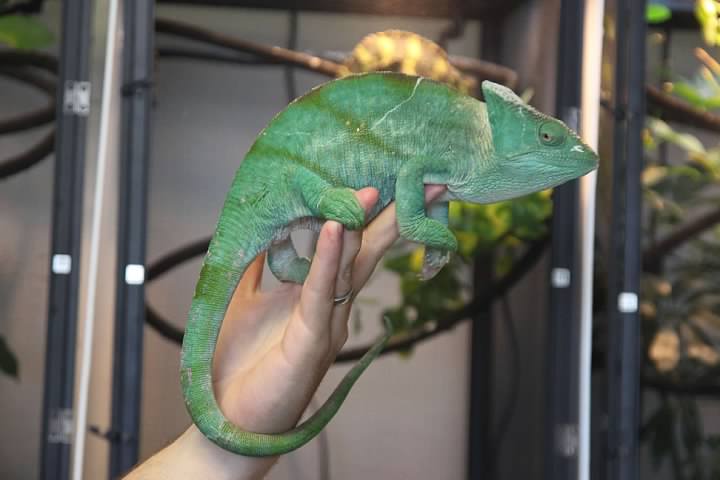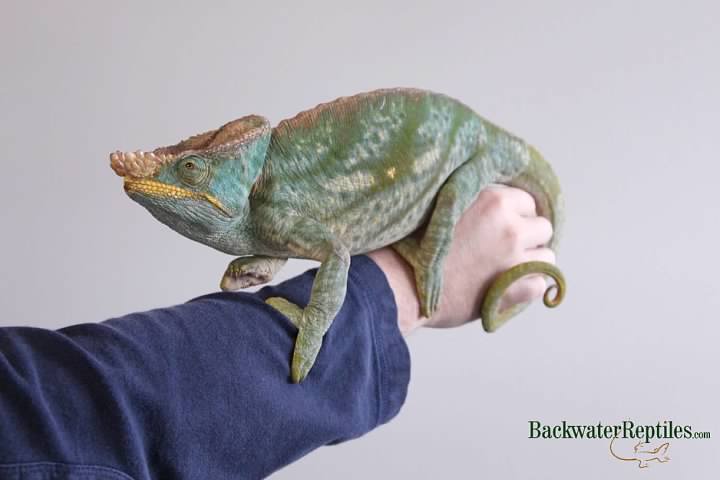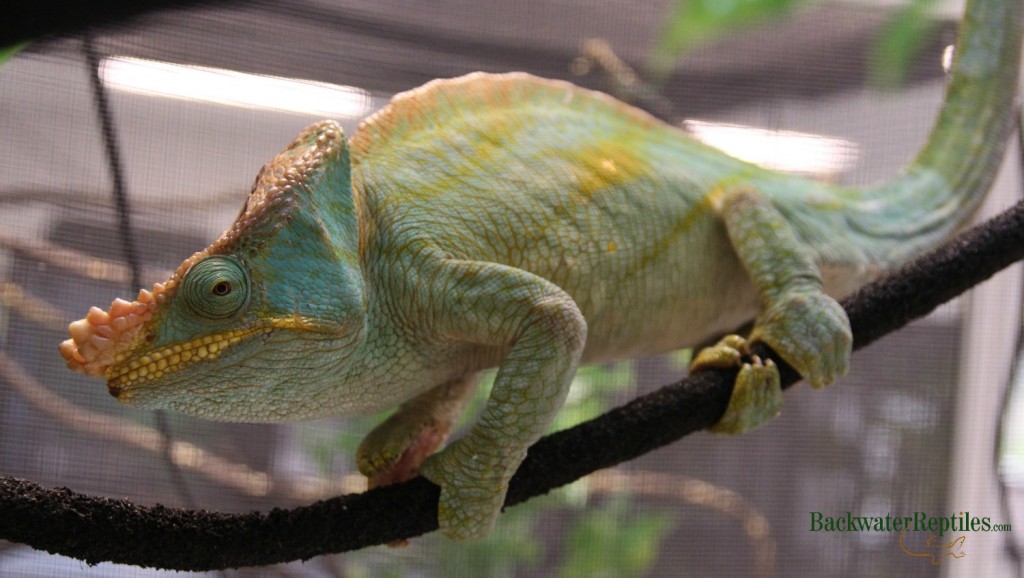A while back, we wrote about the four largest chameleon species and you learned that the biggest chameleon species in the world is the Parson’s Chameleon (Calumma parsonii).
Now, we’re going to tell you a bit more about the gigantic Parson’s Chameleon and why we recommend that only experienced reptile enthusiasts keep these gorgeous and impressive lizards.
Parson’s chameleons are usually a blue-ish greenish teal in color with accent colors of brown, yellow, or green. There are two main varieties seen in the reptile trade: orange eyes, and yellow-lips.
Orange eyes are much more common, and are named so because their eye turrets are a bright, vivid orange color.
Yellow-lips are far less commonly seen in the hobby. Males have yellow trimming on their lips with diagonal stripes along their sides, while females are similarly patterned but generally lack the yellow-lips.

Males Parson’s are larger than females, although not by much. Males also have pronounced nose bumps or protrusions, whereas females do not.
So, we’ve already established that the Parson’s Chameleon is the biggest chameleon species in the world, but how large is it really?
Well, they can reach lengths of up to 30 inches and weigh anywhere from a pound to two pounds. This might not seem like a lot, but when compared to what other chameleons weigh, it’s monstrous! It’s possible that they are not the longest chameleon in the world, but they are certainly the biggest chameleon when it comes to overall mass.
They also have thick, bulky torsos with very strong limbs. In fact, if you ever get the chance to hold one, it might be wise to wear gloves as they have sharp toe claws and can grip hard enough to leave marks and draw blood, although we think it’s worth it!
Often times, it is said that Parson’s chameleons can get as big as a small house cat. This is only partially true as they can get as long as a small cat, but definitely will never weigh as much or be as bulky. They can definitely live as long as a house cat though – some have been reported to live to well over twenty years of age!
Because of their large size, it would make sense that Parson’s chameleons require a large enclosure. A full-grown male or female being housed solitarily should have a mesh cage that is at least 24 inches long and 48 inches high, but the larger the better.
Parson’s are arboreal and will need as much space as possible to climb, so considering how big the animal can be, vertical space is definitely important. Make absolutely sure the vines and branches are strong enough to support their weight easily. Also make sure they cannot wrap their claws all the way around the entire vine/branch width, as this can cause issues for them.

In addition to requiring a large cage, we don’t recommend Parson’s chameleons for beginners because they also need large food items. In the wild, it has been reported that Parson’s eat small birds (finches), so they definitely have appetites and will need to be fed accordingly.
At Backwater Reptiles, we feed ours large roaches, large crickets, and large hornworms. If your Parson’s is particularly well-trained, you might even try feeding it pinkie mice, but it’s usually hard to get chameleons of any species to eat on cue, especially if the food item is already deceased.
Parson’s chameleons are quite rare in the reptile hobby and breeding world for several reasons. Probably the most impactful reason is that these chameleons are listed as “near threatened” on the IUCN’s Red List of Threatened Species.
What this ultimately means is that trade and exportation of these large lizards has been strictly regulated since 1994. It wasn’t until just recently that legal export quotas opened up in their home country of Madagascar, but there are still very few of these animals for sale in captivity, and that’s probably a good thing. Regardless, it’s always best to start with captive bred animals if possible.

The rarity of the Parson’s chameleon means that it comes with a steep price point. Most chameleon species have been captive bred in the U.S. for long enough that that they are not too hard to come by at reptile expos or through private breeders.
But due to the toughness of acquisition as well as the lack of captive breeding projects, Parson’s are still extremely expensive, particularly when compared to other pet chameleon species, often times fetching a price of $1,500 to $3,000, depending upon the locale.
So now let’s assume that you can meet the requirements mentioned above – you’ve got the large cage, you can supply the large food, and you can meet the steep price point. We still recommend that only owners who have kept other species of chameleons own Parson’s chameleons.
Parson’s are particularly delicate, despite their large frames. They stress easily and don’t reproduce in captivity as readily as other species do. And just like all chameleon species, they require high humidity, and a dripping/misting system so that they’ll drink water. They drink a lot of water.

Biggest chameleon species – Conclusion
While Parson’s Chameleons are highly sought after due to their large size, magnificent coloration, and rarity, Backwater Reptiles would like to stress that these animals do best when kept by an experienced reptile hobbyist.
If you think you are interested in one of these chameleons, Backwater Reptiles does have Parson’s Chameleons for sale. We’re always here for questions or pictures of the exact Parson’s chameleons we offer.
